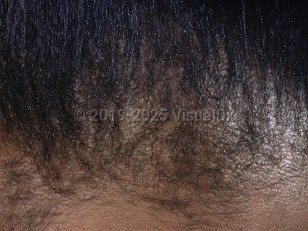Traction alopecia in Child
See also in: Hair and ScalpAlerts and Notices
Important News & Links
Synopsis

Traction alopecia (TA) is a condition of the scalp secondary to trauma of the hair shaft. The hair shaft is weakened by various hair grooming practices including frequent tight braiding, use of elastic bands and tight rollers, tight ponytails, decorative cornrows, and excessive brushing or heat at the roots. Chemically relaxed hair with these styles is more susceptible to traction alopecia. It presents initially as a nonscarring alopecia that can result in permanent hair loss if not treated or if the insult persists.
TA usually involves the temporal region bilaterally, but the condition can be found on any area of the scalp where hair is pulled tightly in various hairstyles, eg, braids, weaves, ponytails, and dreadlocks. Symptoms of a tender, itchy scalp and headaches may be reported.
TA is more common in women and girls, particularly of African descent. This is attributed to the unique mechanical features of African hair and the type of hair grooming that is practiced in certain cultures. African hair is drier, asymmetrical, and helical in shape, which lead to points of weaknesses along the hair shaft. This makes it more susceptible to breakage during combing and to TA when hair is worn in tight styles for prolonged periods. TA is worsened if the hair is chemically relaxed because relaxers weaken the tight disulfide bonds, rendering the hair shaft thinner and drier.
TA is seen in indigenous populations in Western Greenland, young Danish girls with ponytails, ballet dancers, and any ethnic group that styles hair with tension to the frontal region of the scalp. TA also occurs with work-related gear such as helmets, hair caps, headbands, and nurses' caps. It is also seen in religious gear, eg, nuns' coifs and Sikh men who wear turbans.
TA usually involves the temporal region bilaterally, but the condition can be found on any area of the scalp where hair is pulled tightly in various hairstyles, eg, braids, weaves, ponytails, and dreadlocks. Symptoms of a tender, itchy scalp and headaches may be reported.
TA is more common in women and girls, particularly of African descent. This is attributed to the unique mechanical features of African hair and the type of hair grooming that is practiced in certain cultures. African hair is drier, asymmetrical, and helical in shape, which lead to points of weaknesses along the hair shaft. This makes it more susceptible to breakage during combing and to TA when hair is worn in tight styles for prolonged periods. TA is worsened if the hair is chemically relaxed because relaxers weaken the tight disulfide bonds, rendering the hair shaft thinner and drier.
TA is seen in indigenous populations in Western Greenland, young Danish girls with ponytails, ballet dancers, and any ethnic group that styles hair with tension to the frontal region of the scalp. TA also occurs with work-related gear such as helmets, hair caps, headbands, and nurses' caps. It is also seen in religious gear, eg, nuns' coifs and Sikh men who wear turbans.
Codes
ICD10CM:
L66.89 – Other cicatricial alopecia
SNOMEDCT:
67488005 – Traumatic alopecia
L66.89 – Other cicatricial alopecia
SNOMEDCT:
67488005 – Traumatic alopecia
Look For
Subscription Required
Diagnostic Pearls
Subscription Required
Differential Diagnosis & Pitfalls

To perform a comparison, select diagnoses from the classic differential
Subscription Required
Best Tests
Subscription Required
Management Pearls
Subscription Required
Therapy
Subscription Required
References
Subscription Required
Last Reviewed:09/05/2019
Last Updated:10/06/2022
Last Updated:10/06/2022
 Patient Information for Traction alopecia in Child
Patient Information for Traction alopecia in Child
Premium Feature
VisualDx Patient Handouts
Available in the Elite package
- Improve treatment compliance
- Reduce after-hours questions
- Increase patient engagement and satisfaction
- Written in clear, easy-to-understand language. No confusing jargon.
- Available in English and Spanish
- Print out or email directly to your patient
Upgrade Today

Traction alopecia in Child
See also in: Hair and Scalp
